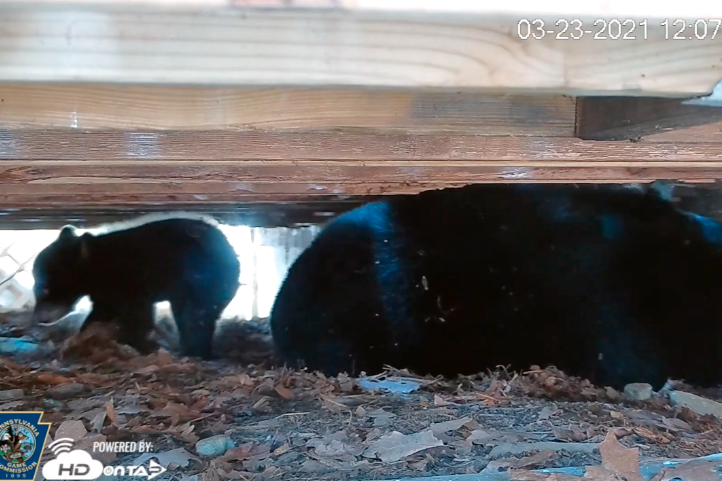
January 26, 2023
 Source/HDOnTap
Source/HDOnTap
The revived black bear livestream follows a mother and three cubs in Pike County. The 2021 stream, captured above, was broadcast from Monroe County.
After taking a year off, the Pennsylvania Game Commission has revived its popular bear cam livestream with a new location in Pike County, in the northeastern part of the state.
The 24/7 video feed follows a mother black bear and her three cubs, who were born earlier this month. The exact location of the den is not disclosed in order to protect the bears.
The game commission offers insights and viewing tips for the bear cam, which is hosted by long-time partner HDOnTap. The remote-controlled camera includes both audio and night vision with the ability to pan, tilt and zoom. The highlights section on the live-streaming site will collect clips of the bear cubs wrestling together and the family venturing out of the den into the woods nearby.
The last time the bear cam was up and running was nearly two years ago at a den beneath a cabin deck in Monroe County, where the bear cam originally debuted in 2019.
Pennsylvania’s black bears usually are born in January. They begin walking after about eight weeks and leave the den at about three months old. When young cubs start to mature in the spring, mother bears will usually take them to the surrounding woods, where they'll learn how to climb and search for food. During the 2019 run of the black bear livestream, the bears left the den on April 11.
Most cubs stay with their mothers for just over a year. The fathers do not play a role in rearing cubs. The family usually separates after about 18 months, and the sows will then breed again.
Pennsylvania's black bear population has fluctuated over the last few years, falling from about 20,000 in 2019 to about 16,200 in 2021 and returning to roughly 18,000 last year, according to the Game Commission. This is considered a healthy and acceptable population for Pennsylvania, where interest in bear hunting also has increased considerably over the last several years. The state's black bear population fell as low as about 4,000 in the 1970s.
The growth of the state's black bear population has also led to an increase in sightings in more densely populated areas of southeastern Pennsylvania, including in Philadelphia and its suburbs. The bears have expanded their territories in the state to seek out new food sources and mates during the early summer months.
In neighboring New Jersey, where legal battles have made annual bear hunts scattershot, the growing population of black bears has led to concern about adopting a sustainable wildlife management policy. In its return late last year, the revived bear hunt hit just a 7% harvest rate, falling short of the state's 20% goal.
Black bears can live up to 25 years in the wild. Although curious and intelligent in their quest for food, they're rarely threats to people and can be scared off by loud noises. They can be a danger to pets who are left unattended in areas where bears roam.
On the bear cam in Pike County, viewers can listen for grunts, huffs and mumbles that the mother bear uses to communicate with her cubs. It's also possible to spy nursing, purring or crying cubs.
Through its partnership with HDOnTap, the Game Commission also hosts the popular Hanover Eagle Cam and Farm County Eagle Cam, as well as its snow goose livestream and summer elk cam.
“While all of our wildlife livestreams are popular with viewers, there’s nothing like watching and listening to bear cubs as they begin to explore their surroundings and, ultimately, emerge from the den with their mothers to see their new world in Penn’s Woods,” Game Commission education director Steve Smith said. “We’re glad to bring back this livestream for 2023 and offer it alongside our annual wintertime wildlife cams, all of which entertain and educate viewers, and give them a whole new appreciation for wildlife."